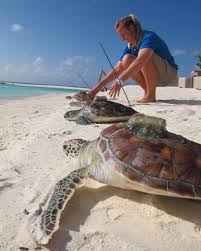In the turquoise lagoon of Banyan Tree Vabbinfaru, Moosa Shan dove down and cleared sand from a large block of cement. There, he placed several balls of marine cement and attached broken fragments of live coral. The balls would harden within hours and provide a critical stable base for coral growth.
Vabbinfaru’s shallow lagoon is dotted with coral gardens of all ages. The oldest garden has been there for fifteen years. The small fragments have now flourished into a vibrant colony, with ornamental fish darting amongst thorny branches and iridescent blue clams visible in the crevices of boulder corals.
The Banyan Tree hotel chain pioneered coral propagation or artificial reef building in the Maldives following a mass coral die off in 1998.
That year, the global El Niño weather event warmed Maldivian waters to 33 degrees Celsius, resulting in coral polyps expelling the algae living in their tissues and bleaching white. The algae provide the polyps with its food, and polyps died after a prolonged period without food.
Over 90 percent of Maldivian reefs died in the 1998 bleaching event.
In May, scientists have predicted an El Niño event comparable to 1998 levels for 2014 and 2015 which could spell disaster for the Maldives’ reefs.
‘The idea that this wondrous ecosystem may just die out in front of your eyes – I cannot really fathom it. If an El Niño occurs, there’s really nothing you can do to prevent coral death,” said Moosa, a conservationist at Banyan Tree.
Marine biologist Alexia Pihier at consulting company Seamarc said scientists have predicted a 70 percent chance of a strong El Niño event developing in the coming months.
If a strong El Niño develops, the Maldives may see bleaching starting in December and peaking in March 2015, she said.
“We are very worried. We are monitoring data from atmospheric scientists closely. There is uncertainty. But if it happens, there is not much we can do,” she said.
Artificial reef building
In the event of massive coral die-off, coral propagation methods practiced in the Maldives, on Banyan Tree Vabbinfaru and by Seamarc on Four Seasons Resorts at Kuda Huraa and Landagiraavaru Islands, offer a glimmer of hope.
According to Moosa, over 90 percent of Vabbinfaru’s reef died in 1998. But sixteen years later, with careful management, the reef has bounced back.
Vabbinfaru’s coral reef today is a kaleidoscope of colors. Among terraced table corals, schools of multi-colored fish roam, as larger fish and strong-jawed eels peek out from coral overhangs.
Moosa and his team dive every few weeks to remove coral predators, including the prickly crown-of-thorns starfish.
In 2001, the Banyan Tree Marine Center also sunk a giant lotus-shaped metal structure on the reef slope. Naturally broken pieces of coral were tied with cable ties to the latticed lotus.
The lotus was then connected to a power source on the shore. Low voltage electricity was run through the structure to help white limestone accrue around the metal. Over the years, coral larvae have settled and grown on the clean limestone rock.
Today, the lotus is an underwater amazement. On any given day, divers and snorkelers can see spotted eagle rays and black tipped reef sharks near the structure.
Between 70 and 90 percent of transplanted corals, both on the lotus and coral gardens have survived, explained Moosa.
In 2005, on both Kuda Huraa and Landagiraavaru, Seamarc developed an artificial reef system of interlinked metal coral trays. Coral fragments were tied to the frames and, within two years, the frames produced a full reef effect.
“Once the damage is done, the frames are a method of rebuilding the reef. It also increases biodiversity and improves the overall reef health,” Seamarc’s chief scientist Thomas Leberre said.
Leberre believes artificial reef building to be a viable option for reefs throughout the Maldives in the event of large-scale coral bleaching.
Climate change and human damage
Thomas also said minor coral bleaching events, such as that of 2010 which accompanied a minor El Niño, would better prepare corals for warmer temperatures associated with global warming.
Both the algae and coral polyps could adapt if the warming rate is gradual, he said.
“However, the fear here is that the rate of change may be faster than the rate of adaptability,” he said.
Recent studies suggest that while the overall number of El Niño is unlikely to increase, particularly strong “super El Niños” are likely to occur twice as frequently in a warming world.
Noting that healthier reefs are able to recover faster from bleaching, both Alexia and Moosa have urged Maldivians to limit damage to the reefs.
A 2013 study by conservation organisation Reef Check found local environmental pollution to have suppressed recovery from the catastrophic bleaching event of 1998.
Human activities such as “tourism, reef fishing, coral mining, dredging, reclamation and the construction of maritime structures and pollution represent most impacts on coral reefs,” the study found.
“Protecting the reef starts from the shoreline. We need better waste management and safer disposal of waste to limit reef damage,” said Moosa.
This article is part of an environmental journalism project supported by Banyan Tree Maldives.



